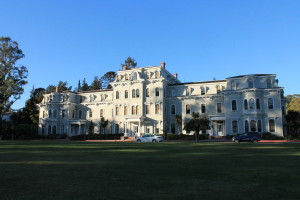
This year, the Center for Contemporary Music (CCM) celebrates 50 years of musical innovation and exploration at Mills College.
The CCM was founded in 1962, as the San Francisco Tape Music Center, a place to push the boundaries of the unexplored territory of electronic music.
“CCM is all about the future, looking forward,” CCM Technical Director Les Stuck said.
Over the years, the Tape Center attracted pioneers and artists like Don Buchla and Pauline Oliveros, who helped shape the Center before and after its transition to the Mills campus in 1967. A few of these original artists from the Tape Center continue to be involved with the CCM today, including Pauline Oliveros who teaches music classes via Skype.
But it is not only its illustrious faculty that has shaped the culture and success of the CCM over the past five decades. Students have always played an integral role to the program’s functionality, dating back to when the program’s biggest claim to fame was its accessibility to the larger public.
“When the center first moved here it had a grant from Rockefeller Foundation, and part of that grant was to provide public access to anyone who wants to learn and make electronic music and access a recording studio,” long-time CCM professor and alumnus Chris Brown said. “The roles of students and staff here were to basically assist community members, who weren’t students, in using the studios and making music with it.”
Many professors teaching at the Center for Contemporary Music today are alumni of its graduate program, including John Bischoff and Maggi Payne.
“I don’t see it as a narrow tradition,” Bischoff said of former students going on to become faculty. “If it’s a healthy tradition, and I think it is, then it provides some continuity. All that I learned here, the ways I was challenged…I try to carry that on as a teacher.”
The passion that today’s students bring to the program certainly hints to the likelihood of the continuity of this tradition. The center’s modest 50th anniversary celebration, for example, was entirely planned by CCM students.
“[The celebration] was really organized and run by the students. Summer of 2016 is the 50th anniversary, but the faculty wasn’t able to put together an appropriately huge thing,” Stuck said. “But the students got all enthusiastic about it.”
On Sept. 22, students and faculty gathered in the Ensemble Room to celebrate the occasion the best way they knew how: with music and innovative performances from both faculty and students alike. The event, which featured a Skype performance from Pauline Oliveros and a variety of both live and pre-recorded pieces, was a fitting celebration for the CCM’s legacy of experimentation, innovation and above all, community.
Next year, the CCM faculty hopes to organize a comprehensive celebration of the CCM’s history in the experimental music tradition. Don Buchla, inventor of one of the first electronic synthesizers and founding member of the Tape Music Center, passed away at the beginning of the semester, and the CCM faculty, all of whom studied his work and many of whom knew him personally, intends to dedicate their anniversary celebrations in his honor.
With the reinvention of the old intermedia program into the new art and technology major, which includes a concentration on creative coding, the CCM has a lot in store for the future.
“I see this new art and technology program as an extension of the CCM’s original mission,” Stuck said.
Though technology and music have both changed drastically since the CCM’s inception, as the program marks half a century of existence, it does not show any signs of slowing down its challenging of musical and technological boundaries.
“It’s a little bit less pioneering now for sure,” Brown said. “But there are still a lot of things that we thought were going to happen that were never quite realized.”



